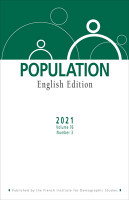
Population 2021, n°3
2021
Exploring the Urban Penalty in Life Expectancy During the Health Transition in Denmark, 1850–1910
Catalina Torres
International Migration and the Growth of Zurich, 1836–1949
Mathias Lerch
Education and Childlessness in India
Thomas Baudin, Koyel Sarkar
Consequences of Migration on Strategies of Adaptation to Coastal Erosion in Senegal: A Typology
Loïc Brüning
Exploring the Urban Penalty in Life Expectancy During the Health Transition in Denmark, 1850–1910
Catalina Torres
During the 19th century, Denmark experienced rapid urban population growth amidst deficient sanitary conditions. This study explores the changes in the country’s life expectancy from 1850 to 1910 for both the total population and the urban and rural areas, using vital statistics data on deaths. It also examines the contributions by causes of death to the changes in life expectancy in Copenhagen. This analysis shows that in Denmark a new mortality regime began to take shape in the 1890s, marking the passage from relatively slow gains in life expectancy and fluctuating mortality to rapid and sustained improvement, especially in cities. Until the 1880s, such gains were driven mainly by mortality reductions among children aged 1–4. From the 1890s, reductions in infant mortality contributed significantly to further gains. Reductions in mortality from a few (mainly infectious) diseases were responsible for most of the gains observed in Copenhagen. Although declining, the urban–rural gap in life expectancy persisted throughout the period, particularly for men.
International Migration and the Growth of Zurich, 1836–1949
Mathias Lerch
The role played by international migration and its interactions with other demographic components in the process of city growth remains underappreciated. We analyze trends in natural increase and in net internal and international migration in Zurich during the Industrial Revolution by relying on historical statistics disaggregated by citizenship and indirect demographic estimation techniques. Our results challenge demographic theories that attribute a predominant role to natural increase in city growth, finding that natural increase was positive only because of the migrants’ contribution. Due to an early fertility decline, Zurich grew essentially through migration, with dramatic changes in the internal and international sources of migrants over time. Our discussion is centered in the context of structural changes in regional and international labor markets, and it further considers Zurich’s discontinuous process of economic development and contrasting migration policies.
Education and Childlessness in India
Thomas Baudin, Koyel Sarkar
Women in the developing country of India have started on the long road to emancipation, at both the family and societal levels. In this context, we study what may be perceived as a key sign of emancipation regarding arriage and motherhood: childlessness. Using micro-level regressions, we show that a woman’s probability of ending her reproductive life without children exhibits a U-shaped relationship with her educational attainment. This indicates that poverty and sterility are not the sole determinants of childlessness and that better economic opportunities and empowerment within couples also matter. This result is robust to the introduction of important control variables, such as the development level of the state where women live, the husband’s education, age at marriage, religion, and caste. India appears to be joining a list of countries whose adjustments to childlessness go far beyond simply responding to boom-and-bust poverty.
Consequences of Migration on Strategies of Adaptation to Coastal Erosion in Senegal: A Typology
Loïc Brüning
The municipality of Gandiol, in northern Senegal, is affected by human-caused coastal erosion whose impact is compounded by climate change. In a region where the main activities are fishing, farming, and livestock production, coastal flooding has led to the salinization of the Senegal River and has contaminated local land and groundwater, destroying the homes and livelihoods of local populations. Faced with this environmental degradation, migration has become a component of the inhabitants’ adaptation strategy. After presenting the specific environmental and migration context of Gandiol, this article presents a typology of migration’s impacts on climate change adaptation strategies. Migrant remittances are used in several ways (to diversify income sources, to optimize investments, or to protect against future risks) and provide a means for women to develop their economic activity.
Catalina Torres completed her PhD in Health Sciences in 2020 from the University of Southern Denmark. Her dissertation focuses on the relationship between life expectancy and urbanization in historical populations. Catalina is a postdoctoral researcher at the French Museum of Natural History, where she is working on a project on the boom in twin births. This project is being conducted jointly with the French Institute for Demographic Studies, where Catalina is also a member of the operations team working on The Demography of COVID-19 Deaths database.

